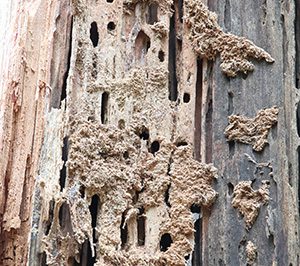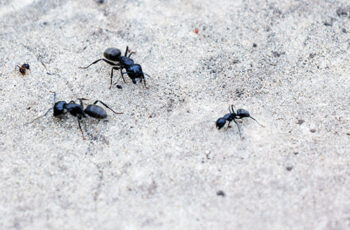
Have you ever dealt with a carpenter ant infestation? If so, we doubt you want to go through that again. Or maybe you’re noticing the signs for the first time and are worried about the extent of damage these pests can inflict. Either way, you’ve come to the right place. With over half a century of ant control experience, Suburban Exterminating is here to impart some of our expertise and equip you with the knowledge you need to protect your home from carpenter ants.
Consider this page your helpful guide for understanding carpenter ants in your home and how to prevent them.
What are the Signs of Carpenter Ants in Your Home?
Often, the first sign of a carpenter ant infestation is the sighting of the ants themselves. You’ve probably seen them before – they’re large black ants. Their color can also vary slightly from reddish to brown, though most are black. If you don’t see the big black ants, there are a few other telltale signs that can indicate their presence, such as:
- Frass: Little piles of chewed wood with a sawdust-like consistency that carpenter ants push out as they build their galleries.
- Noise: Do you hear a faint rustling sound inside walls or wooden structures? It may be carpenter ants.
- Visible Damage: Carpenter ant “galleries” look like smooth tunnels on wooden surfaces.
- Swarming winged ants: Similar to termites, carpenter ants have swarmers. You may notice large piles of winged carpenter ant swarmers emerging from the ground or in crevices or holes in a structure.
- Shed wings: After establishing a new colony, swarmers will shed their wings.
Need Help From an Ant Exterminator?
How to Tell the Difference Between Carpenter Ants and Termites
Carpenter ants and termites are both known for damaging wooden structures – and both species have swarming phases. There are many similarities between carpenter ants and termites, but there are also some key differences to help you tell them apart:
- Waist: Carpenter ants have a clearly defined waist area; termites have a thick waist.
- Antennae: Carpenter ants have bent antennae; termites have straight antennae.
- Wing Length: On a carpenter ant, the front wings are noticeably longer than the back wings. Termites have wings of equal length.
- Damage: Carpenter ants do not eat wood. They excavate wood to create their galleries, leaving behind a smooth appearance. Termites eat wood, leaving behind a more hollowed-out, rough texture.
- Sightings: Carpenter ants are often seen out in the open, especially at night. Termites are less likely to be exposed, as they spend most of their time underground or within walls or wooden structures.
 What Attracts Carpenter Ants?
What Attracts Carpenter Ants?
Carpenter ants dispatch scouts in search of resources; these scouts will venture up to 1000 feet from the colony in their search. Once your home is marked as a resource-rich environment, you might soon find yourself facing an infestation. Any of these factors may help attract carpenter ants to your home:
- Moist wood or water damage
- Excess vegetation and dead trees near your home
- Cracks and crevices in the building’s exterior
- Food spills and crumbs
Ways to Prevent Carpenter Ants in Your Home
Prevention is your best defense against carpenter ants. Here are some tips for keeping them away. As a bonus, doing these things will also help you prevent termites:
- Keep Your Home Dry: Be sure to repair leaks and ensure proper ventilation to avoid moist wood.
- Seal Entry Points: Caulk cracks and crevices around your home’s foundation and windows.
- Trim Vegetation: Keep branches and shrubbery trimmed away from your home.
- Store Firewood Away from the House: Firewood can be infested with carpenter ants without you realizing.
How Much Damage Do Carpenter Ants Do?
Carpenter ants are destructive, but not as destructive as termites. Unlike termites, carpenter ants do not consume the wood. However, the damage can become quite extensive if the infestation is ignored.
Can You Have More Than One Carpenter Ant Colony in Your House?
Yes. A carpenter ant colony may establish satellite colonies when the primary colony becomes too large or crowded – or if a group of ants is cut off from the main colony, perhaps as a result of a previous unsuccessful treatment. Carpenter ant colonies can have as many as a few thousand individuals.
Suffolk and Nassau County’s Carpenter Ant Experts
As the area’s go-to carpenter ant experts, we understand the stress and damage these pests can cause. If you suspect an infestation or just have questions, don’t hesitate to get in touch. Our experienced team is here to provide you with effective solutions and peace of mind.
Protect your home and invest in your peace of mind by choosing our expert services today. For reliable ant control services, call us now.
Back to Ant Exterminators – Control – Removal